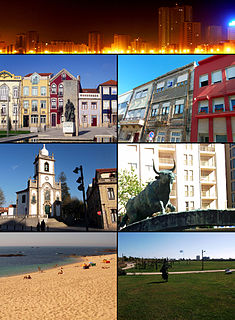António Augusto de Rocha Peixoto was a Portuguese naturalist, ethnologist and archaeologist.

Rua da Junqueira, mostly known simply as Junqueira, is a traditional shopping street in Póvoa de Varzim in Portugal. The street, located in Póvoa de Varzim City Center, it is the main and the oldest shopping street of the city, with several boutiques, some opened for over 100 years, and small shopping centers. Historic architecture was preserved and it is also the most popular tourist area outside the beach in Póvoa de Varzim, attracting millions of visitors. It is a landmark for the city and neighboring areas.
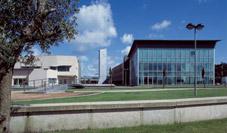
Póvoa de Varzim has public, denominational and independent schools in the city and rural areas. Public education in the municipality is provided by five school districts : Flávio Gonçalves, Cego do Maio, Aver-o-Mar, Campo Aberto, and Rates. These school districts arrange the schools of different locales of the municipality and are headed by EB 2/3 schools that give the name to the respective districts. In terms of independent schools the most distinguished are the Grande Colégio da Póvoa de Varzim and Campo Verde School of Agriculture.

The Castelo da Póvoa, also Fortress of Póvoa de Varzim, officially Fortaleza da Nossa Senhora da Conceição or Nossa Senhora da Conceição Fortress, is a Portuguese fortress in Póvoa de Varzim rebuilt during the reigns of Peter II and John V to defend the town from privateers, in the site of an earlier fort known as "Forte de Torrão". It is considered a listed property of Public Interest in Portugal.

Ethnography and History Museum of Póvoa de Varzim is a museum with a maritime and ethnic theme located in the Portuguese city of Póvoa de Varzim. The museum is located in Solar dos Carneiros, former home of the Viscount of Azevedo.

The Aqueduct of Santa Clara is the second largest Portuguese aqueduct system. Built between 1626 and 1714, it includes 999 arches stretching for 4 kilometres (2.5 mi) from the spring of Terroso in the municipality of Póvoa de Varzim to the Convent of Santa Clara in the municipality of Vila do Conde.

Matriz Church of Póvoa de Varzim, also Nossa Senhora da Conceição Parish Church is the Mother Roman Catholic church in Póvoa de Varzim, Portugal. The temple is located in Praça Velha square, in Bairro da Matriz quarter. The church is dedicated to the Our Lady of the Immaculate Conception, Nossa Senhora da Conceição in Portuguese, the main patron saint of Póvoa de Varzim.
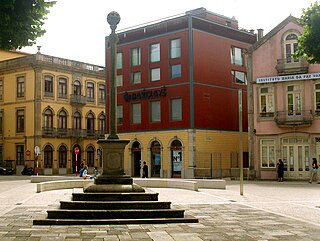
Praça do Almada is the civic center of the city of Póvoa de Varzim in Portugal, and is located in Póvoa de Varzim City Center. It contains the sculpture that pays homage to Eça de Queiroz, a notable writer who was born there.
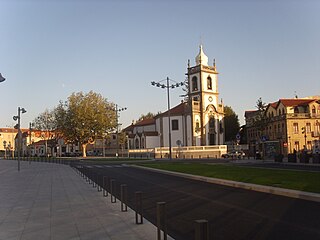
Largo das Dores or Dores Square is a square in Póvoa de Varzim city center in Portugal. Part of the earliest old town of Póvoa de Varzim, this area is listed by City Hall as heritage site. With about 11.000 square meters, its most noticeable features are its two churches, located in the sites of ancient chapels, one of which was the main church of the city.
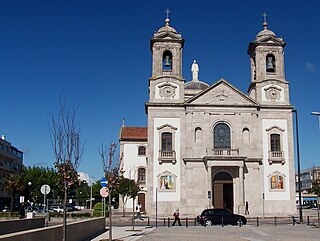
Sagrado Coração de Jesus Basilica or Sacred Heart of Jesus Basilica is a Roman Catholic church, a Jesuit basilica, in Póvoa de Varzim, Portugal. It is part of the parish of Matriz and it is the largest temple in Póvoa de Varzim.

Avenida dos Banhos, is the main waterfront street and a popular tourist attraction in Póvoa de Varzim, Portugal. It roughly encompasses the central waterfront area of Póvoa de Varzim from Passeio Alegre Square and the Port of Póvoa de Varzim to Vasco da Gama Avenue.
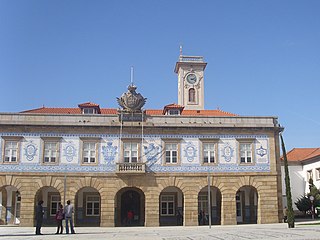
Póvoa de Varzim City Hall is the seat of government of the municipality of Póvoa de Varzim, Portugal. It houses the office of the mayor of Povoa de Varzim, the city council chamber, as well as other city services.

The history of Póvoa de Varzim, Portugal, and its development as a maritime trade and fishing hub, have been greatly influenced by its location at the entrance to one of Portugal's best natural ports.
Hino da Póvoa or Hino da Póvoa de Varzim is an anthem written by Povoan composer Josué Trocado for the city of Póvoa de Varzim in Portugal.
A Filantrópica is an arts cooperative located in Póvoa de Varzim, Portugal. Its headquarters and arts and literature galleries are located in Rua da Lapa street, 1. Currently, the main entrance is located in Rua 31 de Janeiro, a parallel and more important street.

The Port of Póvoa de Varzim is a seaport built in Enseada da Póvoa Bay in the city of Póvoa de Varzim in Portugal. During the Middle Ages, it was known as Port of Varzim.
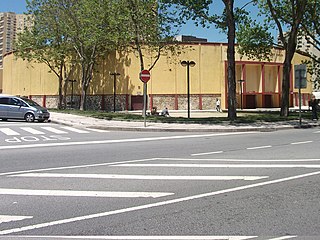
Póvoa de Varzim Bullfighting Arena is a bullring in Póvoa de Varzim, Portugal. It is located in Avenida Vasco da Gama avenue, in the northern waterfront of the city. Bullfighting, horse shows, and concerts are held in the arena.

The architecture of Póvoa de Varzim, in Portugal, demonstrates a broad variety of architectural styles over its thousand years of history. 11th-century Romanesque, 16th-century Mannerism, 18th-century Baroque, late 18th-century neoclassicism, early 20th-century Portuguese modernism and late 20th- to early 21st-century contemporary architectural styles and more are all represented in Póvoa de Varzim. As a whole it represents a rich eclectic tradition and innovation shaped by the people, their beliefs and economy.

